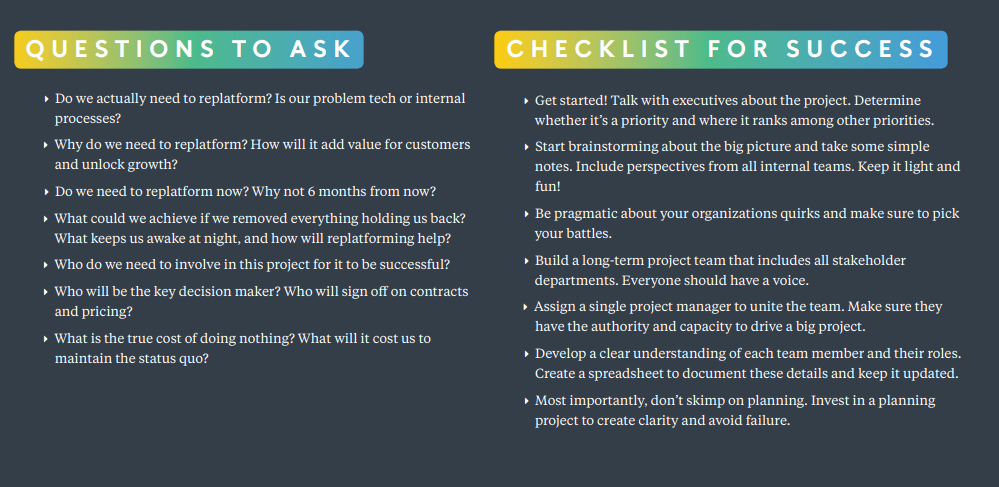
5 Things to Know When Replatforming
[Updated January 20, 2022]
Summary
- It’s important to consider the cost of starting from scratch when evaluating a replatforming project. Most e-commerce companies don’t have the technical resources or desire to maintain their own cloud-based platform… making an upgrade or replatforming are the less expensive approach.
- The initial process of defining strategy and contract negotiations for a new cloud-based platform can take on average three months. Depending on the complexity of the project, it’s safe to assume that the implementation process will take six months minimum.
- It is possible to execute a replatforming project in-house with a sufficiently knowledgeable and experienced team and the correct training. By using an external agency, you receive access to an entire team of trained professionals with the benefit of having deep expertise with these apps.
- Replatforming projects can cost anywhere between $150,000-$300,000 USD with some projects costing less and others costing much more.
- When considering other applications outside of Magento 2, there are multiple cloud-based SaaS solutions available but offer less customization.

Taking on the initiative of investing in a new cloud-based e-commerce platform for your business can be a beast, but we’re here to make things a little more simple. We interviewed Gauge’s Sales Director, Joey Hoer, and asked five crucial questions all eCommerce retailers need to review when thinking about the replatforming journey.
Question #1: Do brands really need to replatform and why? How will it add value for their customers and unlock growth?
A: There are some ideas that embed themselves so deeply into your mind that they change the way you think. For me, one of these ideas came from a blog post by Joel Spolsky titled “Things You Should Never Do, Part I”. In this post, Joel says that “the single worst strategic mistake that any software company can make [is deciding] to rewrite code from scratch” … because “when you throw away code and start from scratch, you are throwing away all that knowledge. All those collected bug fixes. … when you start from scratch there is absolutely no reason to believe that you are going to do a better job than you did the first time.” While it’s natural to refactor and make improvements, “throwing away the whole program is a dangerous folly.”

My preference would be to make continuous improvement to a cloud-based system on a weekly basis; evolving the design and functionality of the app incrementally over time rather than letting updates languish and then investing in a massive overhaul.
When evaluating a replatforming project, it’s important for any retail business to consider the cost of starting from scratch. In the case of Magento 1, consideration must include the fact this application will no longer receive security fixes, bug fixes, or feature additions from Magento after June 2020. Most e-commerce companies don’t have the technical resources or desire to maintain their own cloud-based platform, making an upgrade or replatform the less expensive alternative. For this reason, any Magento 1 customer needs to replatform within the next 12 months.
Platforms are raising expectations for partners when it comes to features and functionality. An e-commerce website must be easy to use and navigate, and products must be easy to find. However, eCommerce growth is rarely achieved through the addition of technical features or apps alone. Customers have more options today than ever before, and if merchants aren’t willing to compete on price, then they must differentiate themselves through their brand.

Question #2: Is there a need to start the process of replatforming now? What about in a few months?
A: The process of defining requirements and strategy, identifying the best agency partners and cloud-based platform for your company, and negotiating a contract may require up to 3 months. In my experience, business owners underestimate the amount of time they’ll require to make this decision.
Delays during the part of this process can almost always be attributed to uncertainty. The best way to make progress and reinforce decision making is with more technical information; hiring a consultant to draft requirements, functional specifications, and recommend specific solutions is a great way to ensure a successful outcome.
Moving from planning to implementation, most e-commerce replatform projects require a customer data migration, design, theme development, third-party integrations, and may require some platform customization or app/extension development. This process usually requires at least 6 months to complete, and may take longer depending upon the complexity of the project. While there may be options to move through this process more quickly, usually those options require compromises that sacrifice uniqueness in how the design is built, functionality, or quality of development.
For these reasons, any Magento 1 customer who is migrating to Magento before June 2020 must begin speaking with partners now to ensure an on-time delivery.

Question #3: Can it be done in house or should brands look to hire someone to help?
A: With a sufficiently knowledgeable and experienced team, it is possible to execute a cloud-based replatforming strategy internally with a positive user experience. Merchants expecting to assemble an internal team must be able to identify and afford an experienced team with varying skill sets. Merchants with an existing team must analyze their team’s talents, experience and expertise, and consider if they have the training required to execute on a large project—particularly when replatforming to a different cloud-based application. One bad hire, or inexperienced individual, can easily derail a replatforming e-commerce project for any business.
By using an external agency, the customer is getting access to an entire team of trained professionals, and they’re not assuming the risk of making bad hiring decisions. Agencies have the benefit of having deep expertise with these apps, because they execute them frequently. Agencies are familiar with roadblocks and issues which typically emerge during a cloud-based replatforming project and have experience resolving them, often allowing them to work more quickly and building a better outcome when compared to a less experienced in-house team.
Question #4: What should brands be expecting to spend on replatforming?
A: The cost of a replatforming project varies greatly based on the company, the quality and experience of the agency, and the requirements of the project. Most of the replatforming projects we’re executing these day are priced between $150,000—$300,000 USD. Some replatforming projects can be completed on a smaller budget, and there are also projects that cost much, much more.
Question #5: What are other recommended, cloud-based options when thinking about replatforming from Magento 1 if brands decide they don’t want to move to Magento 2?
A: Many merchants on the Magento 1 application have some level of customization made to their store. While there are SaaS eCommerce solutions available (e.g. Shopify), these platforms are usually more limiting in terms of customization that can be achieved within the application. This can also be a benefit. Using this type of cloud-based platform that cannot be heavily customized can reduce maintenance and training costs. While there are techniques that allow more advanced features to be added to these SaaS platforms, usually those techniques begin to erode this benefit by requiring more maintenance and upkeep. For this reason, the platform selection must be made based on the company requirements.
If a customer is willing to simplify these to fit within a SaaS application, those options can offer some great benefits. But, if merchants are unwilling to change their business requirements, and they do not fit neatly within a cloud-based SaaS application, then a solution like the Magento 2 application (that is fully-customizable) would likely make a better fit. Again, hiring a consultant business to draft requirements, functional specifications, and recommend a platform solution is a great way to ensure a successful outcome.
7 Other Things to Consider When Replatforming
Management should be able to answer the following questions about their new platform: What are you trying to achieve? Where do you want to go? How are we going to get there? These three questions are especially important because they allow management the opportunity to outline what performance metrics are important for them, what tools they will use in order to measure progress, and how they want the final outcome of these actions to look. Management needs a clear view on where they want the company’s future efforts and time spent on tech support or development should lead. Furthermore, Management should make sure it handles proactively the technical support. You should always learn to use (or improve their use of) tools like ticketing systems, chatbots, and forums so they can better communicate with the tech team on a variety of topics rather than having a single point of contact for IT-related issues.
1) What level of management is needed to effectively run this transition?
During your implementation phase, we recommend at least one person from your organization fully dedicate themselves to the project. This means you will want someone that can regularly communicate with staff members regarding progress, challenges, or even changes made during the setup phase. Once launched into production mode, it is important that someone remains closely tied to this process.
2) How much time should be dedicated to managing the replatforming?
One thing that’s important to keep in mind is that it will take about 3-6 months for your development team or agency to fully get up and running with a new platform, so ensure enough time is set aside in order to complete the project. There may also be training sessions required to orientate staff members on how everything works within their new system, which could add an additional 1-2 months of work if you want them all trained before beginning regular business operations. We recommend committing 6 months instead of 3 just in case something unanticipated occurs during development or training that prolongs the process by another month. Also, keep in mind that staff members will need to be given the opportunity to familiarize themselves with their new tools.
3) What training is required?
Any time a company chooses to switch systems, it is important that staff members are trained on how to use the new platform or software. This could involve anything from refreshing an existing skillset up to learning something entirely new for someone who may have never used eCommerce before. Ultimately, you want everyone using your system to work at full capacity and reach their highest potential efficiency levels as soon as possible. We recommend taking into consideration whether or not any staff has experience using similar products already so they can use this information in order to transition correctly. If no one has ever used a particular system before, make sure to dedicate enough time for training.
4) Will you be using an agency or in-house staff?
If your chosen platform is too complex to simply set up, we recommend working with outside agencies. The last thing you want is your development team struggling to learn how everything functions, especially if they are already strapped for time because of all the other projects they may be currently undertaking. There are plenty of agencies that specialize in this field and can help you get up and running quickly. On the other hand, if it’s something simple like choosing a third-party eCommerce app supported by Shopify or Magento – then yes, it’s totally possible for your own internal team to handle replatforming seamlessly. Also worth mentioning that you will already know everything about your system before they even begin working.
5) What are the major benefits of replatforming?
The biggest benefit is larger business potential through streamlined processes, optimized user experience, and scalable architecture. You will also come out looking more professional to your existing or future customers because of all the tools available on newer eCommerce platforms. Finally, it’s an opportunity for you to get rid of any old tech that may be slowing down your business operations by removing anything unnecessary from your current setup – which could include old systems or software no longer being utilized along with any redundant infrastructure that may have been in place before.
6) What are the main drawbacks of replatforming?
- It takes extra time to complete.
If your development team is currently working on other projects, it could potentially slow them down. However, when working with an agency they should be able to transition seamlessly without any major issues cropping up in their other initiatives. There may also be some resistance from staff members working within the older system who are not looking forward to switching over if they do not understand how much easier it will make their lives moving forward.
- There is a learning curve for staff members working on the project.
It is important that your staff working on this project have some experience working with similar systems. If they are not familiar with anything being used within the product, there will be a learning curve – which unfortunately means no one will be working at full capacity for quite some time.
- Having to decide which platform to use – especially if your company wants something different than what you currently have now…and can cause some intense internal debates!
This is especially true if your current software isn’t working well for your company’s needs.
It will require an investment of time and money to successfully replatform. The ultimate goal, however, is to save both time and money in the long run because of the increased efficiency levels you’ll be working with courtesy of your new platform or software. There are plenty of ways to cut back on cost too – such as working with a third-party partner who can help host the site for you at a much lower price than building it yourself!
Gauge helps build e-commerce websites that grow your brand and your bottom line. For more information on this process, check out Gauge’s Guide to Replatforming.
